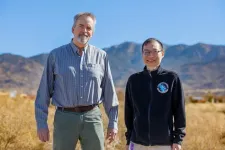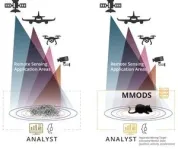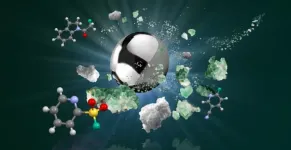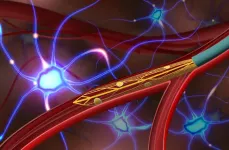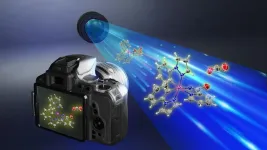(Press-News.org) ALBUQUERQUE, N.M. — Remember what it’s like to twirl a sparkler on a summer night? Hold it still and the fire crackles and sparks but twirl it around and the light blurs into a line tracing each whirl and jag you make.
A new patented software system developed at Sandia National Laboratories can find the curves of motion in streaming video and images from satellites, drones and far-range security cameras and turn them into signals to find and track moving objects as small as one pixel. The developers say this system can enhance the performance of any remote sensing application.
“Being able to track each pixel from a distance matters, and it is an ongoing and challenging problem,” said Tian Ma, a computer scientist and co-developer of the system. “For physical security surveillance systems, for example, the farther out you can detect a possible threat, the more time you have to prepare and respond. Often the biggest challenge is the simple fact that when objects are located far away from the sensors, their size naturally appears to be much smaller. Sensor sensitivity diminishes as the distance from the target increases.”
Ma and Robert Anderson started working on the Multi-frame Moving Object Detection System in 2015 as a Sandia Laboratory Directed Research and Development project. A paper about MMODS was recently published in Sensors.
Detecting one moving pixel in a sea of 10 million
The ability to detect objects through remote sensing systems is typically limited to what can be seen in a single video frame, whereas MMODS uses a new, multiframe method to detect small objects in low visibility conditions, Ma said. At a computer station, image streams from various sensors flow in, and MMODS processes the data with an image filter frame by frame in real time. An algorithm finds movement in the video frames and matches it into target signals that can be correlated and then integrated across a set of video frame sequences.
This process improves the signal-to-noise ratio or overall image quality because the moving target’s signal can be correlated over time and increases steadily, whereas movement from background noise like wind is filtered out because it moves randomly and is not correlated.
Before MMODS was deployed for remote sensing enhancement, Ma and Anderson demonstrated its effectiveness on simulated data with target objects as small as one pixel with a signal-to-noise ratio close to 1:1, meaning there is no distinction between signal and noise.
These objects would normally be undetectable to both human eyes and sensors. The baseline detector system achieved a 30% chance of detecting a moving object. When MMODS was added to that system, it had a 90% chance of detection without increasing the rate of false alarms.
In another demonstration, the researchers used MMODS to detect moving objects from live data collected with a remote camera at the peak of Sandia Mountain. Without prior knowledge of Albuquerque’s roads, MMODS detected vehicles moving throughout the city.
“Given that a modern video camera has about 10 million pixels, being able to detect and track one pixel at a time is a major advance in computer vision technology,” Ma said. “MMODS has been proven to improve modern detection sensitivity by 200 to 500% and works for fast- and slow-moving objects, even in poor visibility conditions.”
END
Detecting threats beyond the limits of human, sensor sight
Sandia-developed software system finds, tracks moving objects as small as a pixel
2023-07-20
ELSE PRESS RELEASES FROM THIS DATE:
Nature inspires breakthrough achievement: hazard-free production of fluorochemicals
2023-07-20
For the first time, Oxford chemists have generated fluorochemicals – critical for many industries – without the use of hazardous hydrogen fluoride gas.
The innovative method was inspired by the biomineralization process that forms our teeth and bones.
The results are published today in the leading journal Science.
A team of chemists have developed an entirely new method for generating critically important fluorochemicals that bypasses the hazardous product hydrogen fluoride (HF) gas. ...
Could early induction of labor reduce inequities in pregnancy outcomes?
2023-07-20
Inducing labor at 39 weeks of pregnancy has the greatest benefit in risk reduction for women from more socioeconomically deprived areas, according to a new study published July 13th in the open access journal PLOS Medicine by Ipek Gurol-Urganci of the London School of Hygiene & Tropical Medicine, UK, and colleagues. The findings suggest that increased uptake of induction of labor at 39 weeks may help reduce inequities in adverse perinatal outcomes.
Adverse perinatal outcomes— which include stillbirths, neonatal ...
Ultra-flexible endovascular probe records deep-brain activity in rats, without surgery
2023-07-20
A new ultra-small and ultra-flexible electronic neural implant, delivered via blood vessels, can record single-neuron activity deep within the brains of rats, according to new study. “This technology could enable long-term, minimally invasive bioelectronic interfaces with deep-brain regions, writes Brian Timko in a related Perspective. Brain-machine interfaces (BMIs) enable direct electrical communication between the brain and external electronic systems. They allow brain activity to directly ...
Northwestern Greenland was ice-free 400,000 years ago, according to Camp Century sediments
2023-07-20
Sediments recovered from the base of the Camp Century ice core show that northwestern Greenland was ice-free during a period of history known to have exhibited some of the lowest global ice volumes -- the Marine Isotope Stage (MIS) 11 interglacial period. The absence of ice at that location means that the Greenland Ice Sheet must have contributed more 1.4 meters of sea-level equivalent to global sea level during the interglacial – a period in which average global air temperature was similar to what we’ll soon experience, given human-caused climate warming. The climate conditions of past interglacials – periods during Earth’s climatic history ...
Global GPS measurements indicate observable phase of fault slip two hours before large earthquakes
2023-07-20
Analysis of Global Positioning System (GPS) time-series data from nearly 100 large earthquakes worldwide has provided evidence for the existence of a precursory phase of fault slip occurring two hours before seismic rupture. “If it can be confirmed that earthquake nucleation often involves an hours-long precursory phase, and the means can be developed to reliably measure it, a precursor warning could be issued,” writes Roland Bürgmann in a related Perspective. The ability to predict large earthquakes has been a longstanding yet elusive goal. Short-term ...
Biobank-scale imaging data unveils the genetic architecture of the human skeletal form
2023-07-20
Combining data from full-body x-ray images and associated genomic data from more than 30,000 UK Biobank participants, researchers have helped illuminate the genetic basis of human skeletal proportions. The findings not only provide new insights into the evolution of the human skeletal form and its role in musculoskeletal disease, but they also demonstrate the utility of using population-scale imaging data from biobanks to understand both disease-related and normal physical variation among humans. Of all primates, humans are the only ones to have evolved to be normally bipedal, an adaptation that may have facilitated the use of tools and accelerated cognitive development. ...
Genes that shape bones identified, offering clues about our past and future
2023-07-20
Using artificial intelligence to analyze tens of thousands of X-ray images and genetic sequences, researchers from The University of Texas at Austin and New York Genome Center have been able to pinpoint the genes that shape our skeletons, from the width of our shoulders to the length of our legs.
The research, published as the cover article in Science, pulls back a curtain on our evolutionary past and opens a window into a future where doctors can better predict patients’ risks of developing conditions such as back pain or arthritis in later life.
“Our research is a powerful demonstration of the impact of AI in medicine, particularly when it comes to analyzing ...
Immune systems develop ‘silver bullet’ defences against common bacteria
2023-07-20
Immune systems develop specific genes to combat common bacteria such as those found in food, new research shows.
Previous theories have suggested that antimicrobial peptides – a kind of natural antibiotics – have a general role in killing a range of bacteria.
However, the new study, published in Science, examined how the immune systems of fruit flies are shaped by the bacteria in their food and environment.
The researchers, from the Swiss Federal Institute of Technology and the University of Exeter, found two peptides that each control a single bacterial species commonly encountered by the flies.
“We know that an animal’s food and environment ...
These bones were made for walking
2023-07-20
NEW YORK, NY--Perhaps the most profound advance in primate evolution occurred about 6 million years ago when our ancestors started walking on two legs. The gradual shift to bipedal locomotion is thought to have made primates more adaptable to diverse environments and freed their hands to make use of tools, which in turn accelerated cognitive development. With those changes, the stage was set for modern humans.
The genetic changes that made possible the transition from knuckle-based scampering in great apes to upright walking in humans have now been uncovered in a new study by researchers ...
Observing the long-postulated intermediate of catalytic amination reactions
2023-07-20
Led by Director CHANG Sukbok, scientists from the Center for Catalytic Hydrocarbon Functionalizations within the Institute for Basic Science (IBS) have made a breakthrough in understanding the structure and reactivity of a key intermediate in catalytic reactions. This intermediate, known as a transition metal-nitrenoid, plays a crucial role in converting hydrocarbons into amides, which are important in pharmaceuticals and materials science.
In chemical reactions, intermediates are substances that are formed and consumed during the transformation of reactants into products. Hence, understanding these intermediates ...
LAST 30 PRESS RELEASES:
Making lighter work of calculating fluid and heat flow
Normalizing blood sugar can halve heart attack risk
Lowering blood sugar cuts heart attack risk in people with prediabetes
Study links genetic variants to risk of blinding eye disease in premature infants
Non-opioid ‘pain sponge’ therapy halts cartilage degeneration and relieves chronic pain
AI can pick up cultural values by mimicking how kids learn
China’s ecological redlines offer fast track to 30 x 30 global conservation goal
Invisible indoor threats: emerging household contaminants and their growing risks to human health
Adding antibody treatment to chemo boosts outcomes for children with rare cancer
Germline pathogenic variants among women without a history of breast cancer
Tanning beds triple melanoma risk, potentially causing broad DNA damage
Unique bond identified as key to viral infection speed
Indoor tanning makes youthful skin much older on a genetic level
Mouse model sheds new light on the causes and potential solutions to human GI problems linked to muscular dystrophy
The Journal of Nuclear Medicine ahead-of-print tip sheet: December 12, 2025
Smarter tools for peering into the microscopic world
Applications open for funding to conduct research in the Kinsey Institute archives
Global measure underestimates the severity of food insecurity
Child survivors of critical illness are missing out on timely follow up care
Risk-based vs annual breast cancer screening / the WISDOM randomized clinical trial
University of Toronto launches Electric Vehicle Innovation Ontario to accelerate advanced EV technologies and build Canada’s innovation advantage
Early relapse predicts poor outcomes in aggressive blood cancer
American College of Lifestyle Medicine applauds two CMS models aligned with lifestyle medicine practice and reimbursement
Clinical trial finds cannabis use not a barrier to quitting nicotine vaping
Supplemental nutrition assistance program policies and food insecurity
Switching immune cells to “night mode” could limit damage after a heart attack, study suggests
URI-based Global RIghts Project report spotlights continued troubling trends in worldwide inhumane treatment
Neutrophils are less aggressive at night, explaining why nighttime heart attacks cause less damage than daytime events
Menopausal hormone therapy may not pose breast cancer risk for women with BRCA mutations
Mobile health tool may improve quality of life for adolescent and young adult breast cancer survivors
[Press-News.org] Detecting threats beyond the limits of human, sensor sightSandia-developed software system finds, tracks moving objects as small as a pixel
